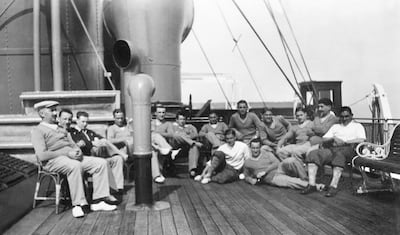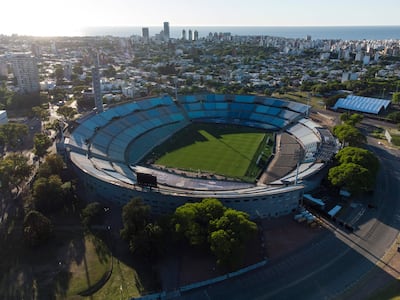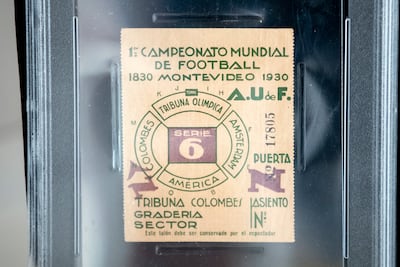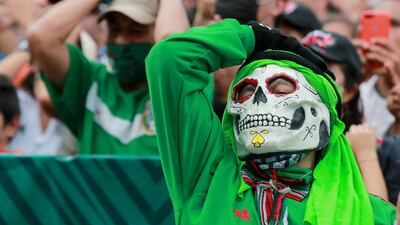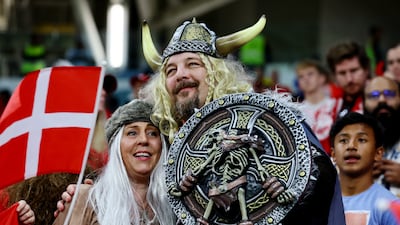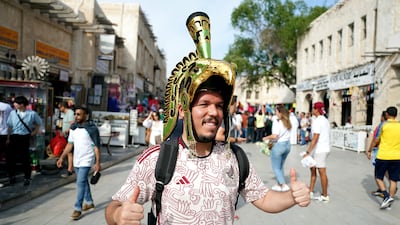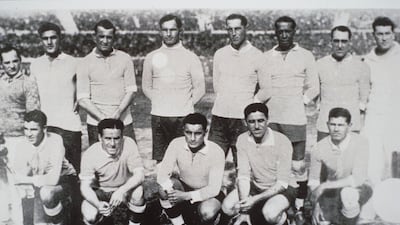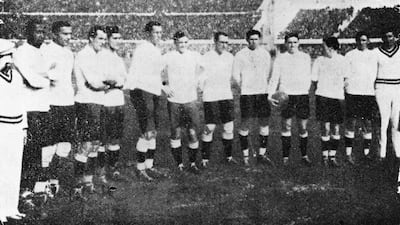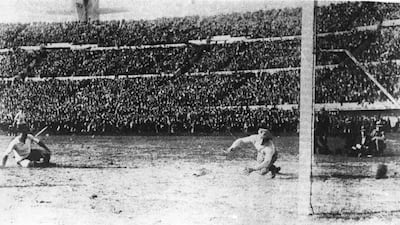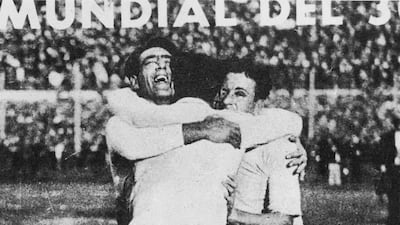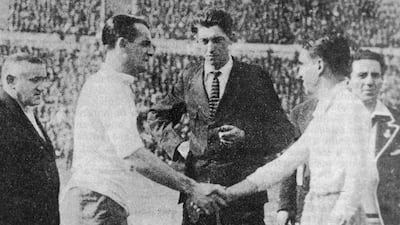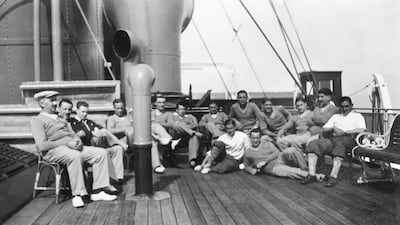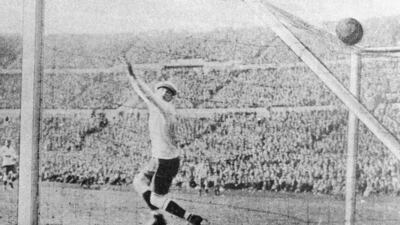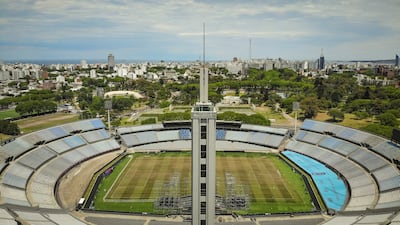Riots, thuggery, snow, berets and a team that literally missed the boat — for sheer craziness the current Qatar World Cup has nothing on the first tournament in 1930.
The host nation was Uruguay, chosen as two-time Olympic champions and with the country celebrating the centennial of its constitution.
No qualification was required, with 16 countries invited, although some of the biggest names in world football were missing.
England felt the competition was beneath them, while Denmark and Germany objected to the inclusion of professional footballers, believing only amateurs should play.
In the end, seven South American countries signed up and only four from Europe. Japan and Siam — now Thailand — sent their apologies, with the journey to South America involving several weeks on a boat in an age before regular air travel.
All the games were played in Montevideo, the Uruguayan capital, using five stadiums, including the 90,000 capacity Estadio Centenario.
Journey far from plain sailing
A month before the World Cup, the European teams prepared to depart for South America and the fun began.
The Romanian squad, selected personally by the king, Carol II, were the first to board the liner Conte Verde as it set sail from the Italian port of Genoa, the players having first endured a gruelling two-day train journey.
At Viilefranche-sur-Mer, near Nice, the ship stopped to pick up the French team, three referees and the then president of Fifa, Jules Rimet, who was carrying the “Victory” trophy, later named in his honour, in a suitcase.
There was another stop in Barcelona to pick up the Belgians, and finally, on the other side of the Atlantic, in Rio do Janeiro, to collect Brazil.
Yugoslavia had left the decision to take part so late that the Conte Verde was fully booked. Instead they travelled to Marseilles to join the mail ship Florida.
Egypt had also booked the Florida but a storm in the Mediterranean delayed them by a day, and they arrived to find the ship had sailed without them, ending their World Cup campaign without a kicking a ball.
Wild weather for World Cup kick off
Over in Uruguay, preparations were chaotic. It had rained solidly for six weeks and the Estadio Centenario, then the second-biggest stadium in the world, after Wembley, had not been finished. It did not host games until five days into the tournament.
France beat Mexico in the opening match on July 13. Unlike Qatar, heat was not the problem, with the match played in the driving snow of a South American winter.
Uruguay had the honour of having the first player sent off in a World Cup and went on to lose 3-1 to Romania in front of the smallest crowd in the tournament’s history, in a stadium with a 1,000 capacity.
Argentina, meanwhile, quickly established themselves as the dirtiest team in the contest. In their opening game with France, a crippling tackle forced the French goalkeeper to leave the pitch after 20 minutes, and there was more controversy when the Brazilian referee blew the final whistle six minutes early and with Argentina leading 1-0.
Argentina then threatened to leave the tournament after a hostile reception from Uruguayan fans who pelted them with stones. With the Argentinian captain returning home to take a law exam, it took a personal intervention from the president of Uruguay to persuade the rest of the team to stay.
A fight for victory
They celebrated with a massive fight in their final game with Chile, broken up by police, but qualified for the knockout stages, along with Uruguay, Yugoslavia and the USA.
These were also the semi-finals, with the Argentina-USA game a classic, at least for those who like to combine comedy with extreme violence.
Four minutes into the game, a foul on the US goalkeeper left him with a badly twisted knee. Six minutes later, a particularly brutal foul broke the leg of US defender Ralph Tracy.
The US trainer, Jack Coll, rushed on to the pitch to confront the referee, who like all officials, was wearing a suit. Coll tripped and accidentally smashed a bottle of chloroform in his pocket, collapsing unconscious from the fumes. He was stretched off the field along with Tracy.
Reduced to nine men, and with no substitutes allowed in those days, the Americans, who fielded six British-born players, succumbed 6-1 to Argentina.
In the other semi-final, the hosts also won 6-1 against tournament underdogs Yugoslavia, who had previously beaten a Bolivian team that played in berets.
That set up a final between Uruguay and neighbours Argentina, then the most bitter rivalry in South American football. Even before the first kick, there was controversy over the ball to be used, with match officials eventually using an Argentinian ball for the first half and a Uruguayan one for the second.
Thousands of Argentinian fans crossed the River Plate border in an armada of small boats, chanting “Victoria o muerte” (victory or death). More than 90,000 spectators crammed into the Estadio Centenario in an atmosphere so intimidating the Belgian referee requested a ship be made available after the game for a quick escape.
Uruguay would win the first World Cup 4-2, sparking massive celebrations and the declaration of a public holiday. In Argentina the mood turned ugly, with an estimated 15,000 fans, who had missed the game after getting lost in fog, rioting. In Buenos Aires the Uruguayan consulate was stoned.
Lost World Cup star back from the dead
The tournament was over but there was a bizarre postscript. After three months, the Romanian team returned home, but without one of their star players, Alfred Feraru, who had been taken ill with pneumonia on the voyage over.
A rumour swept Bucharest that Feraru had died and his distraught family prepared for a funeral. Feraru, now fit and healthy after a stay in an Italian hospital, walked through the door on the day of his wake, prompting his mother to faint.
World Cup 2022 - in pictures
UAE currency: the story behind the money in your pockets
What are the influencer academy modules?
- Mastery of audio-visual content creation.
- Cinematography, shots and movement.
- All aspects of post-production.
- Emerging technologies and VFX with AI and CGI.
- Understanding of marketing objectives and audience engagement.
- Tourism industry knowledge.
- Professional ethics.
The%20Witcher%20-%20season%20three
%3Cp%3E%3Cstrong%3EDirector%3A%20%3C%2Fstrong%3EVarious%0D%3Cbr%3E%3Cstrong%3E%0D%3Cbr%3EStars%3A%20%3C%2Fstrong%3EHenry%20Cavill%2C%20Freya%20Allan%2C%20Anya%20Chalotra%3Cstrong%3E%0D%3Cbr%3E%0D%3Cbr%3ERating%3A%3C%2Fstrong%3E%203%2F5%3C%2Fp%3E%0A
'Peninsula'
Stars: Gang Dong-won, Lee Jung-hyun, Lee Ra
Director: Yeon Sang-ho
Rating: 2/5
Starring: Jamie Foxx, Angela Bassett, Tina Fey
Directed by: Pete Doctor
Rating: 4 stars
Diriyah%20project%20at%20a%20glance
%3Cp%3E-%20Diriyah%E2%80%99s%201.9km%20King%20Salman%20Boulevard%2C%20a%20Parisian%20Champs-Elysees-inspired%20avenue%2C%20is%20scheduled%20for%20completion%20in%202028%0D%3Cbr%3E-%20The%20Royal%20Diriyah%20Opera%20House%20is%20expected%20to%20be%20completed%20in%20four%20years%0D%3Cbr%3E-%20Diriyah%E2%80%99s%20first%20of%2042%20hotels%2C%20the%20Bab%20Samhan%20hotel%2C%20will%20open%20in%20the%20first%20quarter%20of%202024%0D%3Cbr%3E-%20On%20completion%20in%202030%2C%20the%20Diriyah%20project%20is%20forecast%20to%20accommodate%20more%20than%20100%2C000%20people%0D%3Cbr%3E-%20The%20%2463.2%20billion%20Diriyah%20project%20will%20contribute%20%247.2%20billion%20to%20the%20kingdom%E2%80%99s%20GDP%0D%3Cbr%3E-%20It%20will%20create%20more%20than%20178%2C000%20jobs%20and%20aims%20to%20attract%20more%20than%2050%20million%20visits%20a%20year%0D%3Cbr%3E-%20About%202%2C000%20people%20work%20for%20the%20Diriyah%20Company%2C%20with%20more%20than%2086%20per%20cent%20being%20Saudi%20citizens%0D%3C%2Fp%3E%0A
The biog
Name: Marie Byrne
Nationality: Irish
Favourite film: The Shawshank Redemption
Book: Seagull by Jonathan Livingston
Life lesson: A person is not old until regret takes the place of their dreams
Spider-Man%202
%3Cp%3E%3Cstrong%3EDeveloper%3A%3C%2Fstrong%3E%20Insomniac%20Games%0D%3Cbr%3E%3Cstrong%3EPublisher%3A%3C%2Fstrong%3E%20%20Sony%20Interactive%20Entertainment%0D%3Cbr%3E%3Cstrong%3EConsole%3A%20%3C%2Fstrong%3EPlayStation%205%0D%3Cbr%3E%3Cstrong%3ERating%3A%3C%2Fstrong%3E%205%2F5%3C%2Fp%3E%0A
Living in...
This article is part of a guide on where to live in the UAE. Our reporters will profile some of the country’s most desirable districts, provide an estimate of rental prices and introduce you to some of the residents who call each area home.
WOMAN AND CHILD
Director: Saeed Roustaee
Starring: Parinaz Izadyar, Payman Maadi
Rating: 4/5
Who has been sanctioned?
Daniella Weiss and Nachala
Described as 'the grandmother of the settler movement', she has encouraged the expansion of settlements for decades. The 79 year old leads radical settler movement Nachala, whose aim is for Israel to annex Gaza and the occupied West Bank, where it helps settlers built outposts.
Harel Libi & Libi Construction and Infrastructure
Libi has been involved in threatening and perpetuating acts of aggression and violence against Palestinians. His firm has provided logistical and financial support for the establishment of illegal outposts.
Zohar Sabah
Runs a settler outpost named Zohar’s Farm and has previously faced charges of violence against Palestinians. He was indicted by Israel’s State Attorney’s Office in September for allegedly participating in a violent attack against Palestinians and activists in the West Bank village of Muarrajat.
Coco’s Farm and Neria’s Farm
These are illegal outposts in the West Bank, which are at the vanguard of the settler movement. According to the UK, they are associated with people who have been involved in enabling, inciting, promoting or providing support for activities that amount to “serious abuse”.
KILLING OF QASSEM SULEIMANI
More from Armen Sarkissian
More from Neighbourhood Watch:
FIVE%20TRENDS%20THAT%20WILL%20SHAPE%20UAE%20BANKING
%3Cp%3E%E2%80%A2%20The%20digitisation%20of%20financial%20services%20will%20continue%3C%2Fp%3E%0A%3Cp%3E%E2%80%A2%20Managing%20and%20using%20data%20effectively%20will%20become%20a%20competitive%20advantage%3C%2Fp%3E%0A%3Cp%3E%E2%80%A2%20Digitisation%20will%20require%20continued%20adjustment%20of%20operating%20models%3C%2Fp%3E%0A%3Cp%3E%E2%80%A2%20Banks%20will%20expand%20their%20role%20in%20the%20customer%20life%20through%20ecosystems%3C%2Fp%3E%0A%3Cp%3E%E2%80%A2%20The%20structure%20of%20the%20sector%20will%20change%3C%2Fp%3E%0A
F1 line ups in 2018
Mercedes-GP Lewis Hamilton and Valtteri Bottas; Ferrari Sebastian Vettel and Kimi Raikkonen; Red Bull Daniel Ricciardo and Max Verstappen; Force India Esteban Ocon and Sergio Perez; Renault Nico Hülkenberg and Carlos Sainz Jr; Williams Lance Stroll and Felipe Massa / Robert Kubica / Paul di Resta; McLaren Fernando Alonso and Stoffel Vandoorne; Toro Rosso TBA; Haas F1 Romain Grosjean and Kevin Magnussen; Sauber TBA
Kanguva
Director: Siva
Stars: Suriya, Bobby Deol, Disha Patani, Yogi Babu, Redin Kingsley
Founders: Abdulmajeed Alsukhan, Turki Bin Zarah and Abdulmohsen Albabtain.
Based: Riyadh
Offices: UAE, Vietnam and Germany
Founded: September, 2020
Number of employees: 70
Sector: FinTech, online payment solutions
Funding to date: $116m in two funding rounds
Investors: Checkout.com, Impact46, Vision Ventures, Wealth Well, Seedra, Khwarizmi, Hala Ventures, Nama Ventures and family offices
Timeline
2012-2015
The company offers payments/bribes to win key contracts in the Middle East
May 2017
The UK SFO officially opens investigation into Petrofac’s use of agents, corruption, and potential bribery to secure contracts
September 2021
Petrofac pleads guilty to seven counts of failing to prevent bribery under the UK Bribery Act
October 2021
Court fines Petrofac £77 million for bribery. Former executive receives a two-year suspended sentence
December 2024
Petrofac enters into comprehensive restructuring to strengthen the financial position of the group
May 2025
The High Court of England and Wales approves the company’s restructuring plan
July 2025
The Court of Appeal issues a judgment challenging parts of the restructuring plan
August 2025
Petrofac issues a business update to execute the restructuring and confirms it will appeal the Court of Appeal decision
October 2025
Petrofac loses a major TenneT offshore wind contract worth €13 billion. Holding company files for administration in the UK. Petrofac delisted from the London Stock Exchange
November 2025
180 Petrofac employees laid off in the UAE
UK’s AI plan
- AI ambassadors such as MIT economist Simon Johnson, Monzo cofounder Tom Blomfield and Google DeepMind’s Raia Hadsell
- £10bn AI growth zone in South Wales to create 5,000 jobs
- £100m of government support for startups building AI hardware products
- £250m to train new AI models
Spider-Man: No Way Home
Director: Jon Watts
Stars: Tom Holland, Zendaya, Jacob Batalon
Rating:*****
Semi-final fixtures
Portugal v Chile, 7pm, today
Germany v Mexico, 7pm, tomorrow
More from Rashmee Roshan Lall
Groom and Two Brides
Director: Elie Semaan
Starring: Abdullah Boushehri, Laila Abdallah, Lulwa Almulla
Rating: 3/5
Dunki
%3Cp%3E%3Cstrong%3EDirector%3A%3C%2Fstrong%3E%20Rajkumar%20Hirani%C2%A0%3C%2Fp%3E%0A%3Cp%3E%3Cstrong%3EStarring%3A%3C%2Fstrong%3E%20Shah%20Rukh%20Khan%2C%20Taapsee%20Pannu%2C%20Vikram%20Kochhar%20and%20Anil%20Grover%3C%2Fp%3E%0A%3Cp%3E%3Cstrong%3ERating%3A%3C%2Fstrong%3E%204%2F5%3C%2Fp%3E%0A
Our legal consultant
Name: Hassan Mohsen Elhais
Position: legal consultant with Al Rowaad Advocates and Legal Consultants.
A MINECRAFT MOVIE
Director: Jared Hess
Starring: Jack Black, Jennifer Coolidge, Jason Momoa
Rating: 3/5
Biggest%20applause
%3Cp%3EAsked%20to%20rate%20Boris%20Johnson's%20leadership%20out%20of%2010%2C%20Mr%20Sunak%20awarded%20a%20full%2010%20for%20delivering%20Brexit%20%E2%80%94%20remarks%20that%20earned%20him%20his%20biggest%20round%20of%20applause%20of%20the%20night.%20%22My%20views%20are%20clear%2C%20when%20he%20was%20great%20he%20was%20great%20and%20it%20got%20to%20a%20point%20where%20we%20need%20to%20move%20forward.%20In%20delivering%20a%20solution%20to%20Brexit%20and%20winning%20an%20election%20that's%20a%2010%2F10%20-%20you've%20got%20to%20give%20the%20guy%20credit%20for%20that%2C%20no-one%20else%20could%20probably%20have%20done%20that.%22%3C%2Fp%3E%0A
